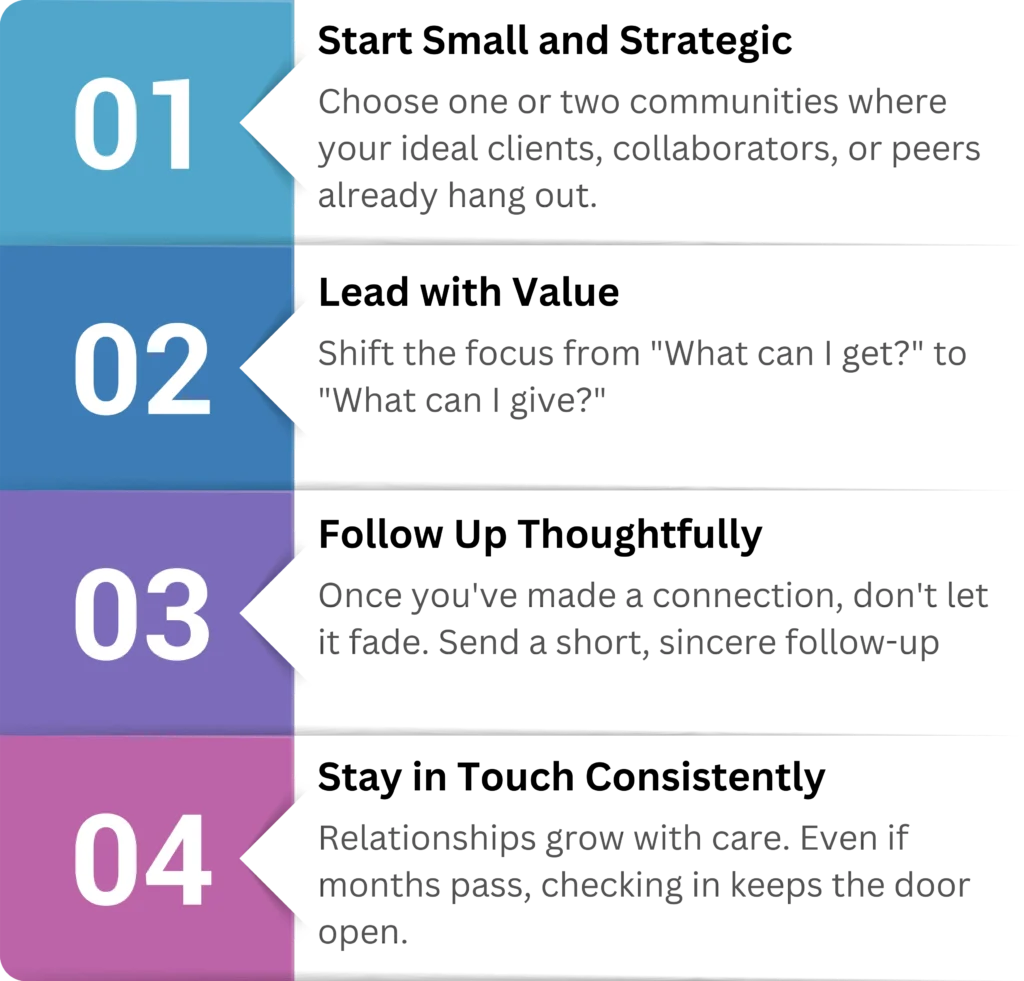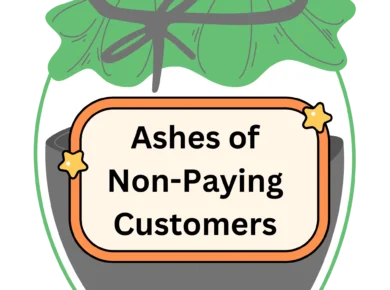You’ve sent out a dozen client proposals this month—nothing but crickets. You tweak your pricing, polish your pitch, and maybe even question your skills. But here’s the truth: success isn’t always about what you offer—it’s often about who you’re connected to.
If you’ve ever wondered what is networking—and more importantly, how to make it work for you as a freelancer or solopreneur—you’re in the right place. In this article, we’ll explore the difference between networking and building professional relationships, why it matters, and how to do it in a way that feels authentic, not awkward.
You’ll learn a simple 4-step plan to help you connect with others more meaningfully, avoid common networking mistakes, and stay organized with tools that make follow-ups easier (including a free downloadable tracker!).
Because here’s the thing: many independent professionals find that their biggest breakthroughs don’t come from cold emails or job boards—they come from trust, conversations, and community.
In fact, according to LinkedIn, 85% of jobs are filled through networking, not traditional applications.
If that number surprised you, you’re not alone. But it also means there’s a huge opportunity ahead—one rooted in real connection and building professional relationships that last.
Key Concept: Networking Is Just the Start—Relationships Are the Real Goal
It’s easy to think of networking as simply swapping business cards or sending a few LinkedIn connection requests. But for freelancers and solopreneurs, surface-level interactions rarely lead to lasting results.
The real key? Building professional relationships—the kind that go beyond small talk and create long-term mutual value.
| Networking | Relationship Building |
|---|---|
| Meeting new people | Nurturing those connections over time |
| One-time conversations | Ongoing, meaningful interactions |
| Focused on personal gain | Rooted in mutual trust and shared value |
| Exchanging contact info | Following up, supporting, and staying in touch |
In short: networking plants the seed, but relationship-building is what helps it grow.
And yes—tools matter too. Whether you’re reaching out to a new lead or reconnecting with someone you met at an event, it helps to find the email addresses of your contacts quickly and accurately. That small step can open the door to deeper conversations and lasting collaborations.
When done right, networking isn’t about who you know today—it’s about who you’re willing to grow with over time.
Real-Life in Action: How Relationships Create Results
To bring these ideas to life, let’s look at a couple of fictional freelancer scenarios that show how building professional relationships can pay off in tangible, meaningful ways.
🧑🎨 Alex, the freelance designer
Alex joined a Slack community for independent creatives—not to pitch his services but to contribute. He offered feedback on others’ portfolios, shared useful tools, and asked thoughtful questions. Over time, people began to notice his generosity and skill. Within three months, he landed two new clients—both referrals from group members who trusted him because of the value he consistently offered.
🧑💻 Samira, the content writer
Samira reached out to a former colleague she hadn’t spoken to in over a year. Instead of jumping into a sales pitch, she simply checked in, congratulated them on a recent project, and shared an article she thought they’d enjoy. That thoughtful message led to a coffee chat—and, eventually, a new long-term retainer client. The key? She approached the connection with curiosity and care, not a transaction in mind.
📝 These are fictional examples, shared to help you visualize what successful relationship-building can look like in everyday freelancing.
You don’t need a massive network to start seeing results—just a few authentic relationships nurtured with intention.
Your Action Plan: 4 Steps to Build Meaningful Professional Relationships
Here’s how to start building professional relationships that matter.
Step 1: Start Small and Strategic
Choose one or two communities where your ideal clients, collaborators, or peers already hang out. Think:
- Niche Slack or Discord groups
- LinkedIn communities tied to your industry
- Local or virtual freelancer meetups
- Reddit communities
📌 Pro Tip: Don’t just join—observe first. Then start showing up with helpful comments, questions, or ideas.
Step 2: Lead with Value
Shift the focus from “What can I get?” to “What can I give?” Small gestures build trust:
- Share a resource, tool, or article
- Offer a thoughtful comment or encouragement
- Make an introduction that could help them
The goal? Be someone others enjoy hearing from—even when you’re not pitching anything.
Step 3: Follow Up Thoughtfully
Once you’ve made a connection, don’t let it fade. Send a short, sincere follow-up:
- Reference a part of your conversation
- Offer something useful or encouraging
- Suggest a time to reconnect, if relevant
💬 Keep it casual, kind, and personal—not robotic.
Step 4: Stay in Touch Consistently
Relationships grow with care. Even if months pass, checking in keeps the door open. You can:
- Congratulate them on a milestone or project
- Send a “thought of you when I saw this” message
- Respond to something they’ve posted or shared
📅 Use a simple CRM or a spreadsheet to track your outreach rhythm, so it stays natural and low-pressure.
Pitfalls & Roadblocks: What to Watch Out For
Even with the best intentions, it’s easy to fall into a few common networking traps—especially when you’re juggling client work, admin tasks, and the hustle of freelancing.
Here are a few missteps to avoid—and what to do instead:
1: Spamming DMs Without Context
Sending cold messages that feel like copy-paste pitches is a fast way to lose trust.
✅ Quick Fix: Take a moment to personalize your outreach. Mention something you genuinely appreciated in their work or content. Be human, not salesy.
2: Joining Too Many Groups Without Showing Up
It’s tempting to join every Slack, Facebook, or LinkedIn group out there—but lurking without engaging won’t get you far.
✅ Quick Fix: Choose 1–2 quality communities and commit to showing up regularly. Comment, ask questions, or share something useful. Relationships grow through presence.
3: Only Reaching Out When You Need Something
No one likes to feel used. If the only time you message someone is to ask for help, it can damage trust.
✅ Quick Fix: Schedule “networking maintenance” check-ins once a month. Reach out with no agenda—just to say hi, share something interesting, or cheer someone on.
4: Expecting Instant Results
Networking isn’t magic—it’s a slow burn. If you’re hoping for overnight wins, frustration will follow.
✅ Quick Fix: Think long game. You’re planting seeds that might bloom in a few weeks, months, or even years. That’s normal—and powerful.
| ❌ Not That | ✅ Do This Instead |
|---|---|
| 💬 Spamming DMs with generic messages | 💌 Personalize outreach with genuine interest |
| 🧑🤝🧑 Joining every group you find | 🎯 Choose 1–2 groups and engage consistently |
| 🙄 Only messaging when you need something | 🤝 Check in regularly with no ask—just connection |
| ⏳ Expecting quick wins | 🌱 Play the long game and build trust over time |
💡 Remember: relationship-building is a craft, not a race. Each thoughtful interaction builds your reputation, your community, and your future opportunities.
Download: Your Networking Tracker Template
Keep your connections organized and your follow-ups intentional with our easy-to-use Networking Tracker Template.
Use it to log:
- Contact names & where you met
- Follow-up dates
- Notes on shared interests or potential collaborations
- Reminders to check in
➡️ [Download the Networking Tracker

PRO TIP
You can use this tracker alongside PlanArty to schedule your next interactions—so you never miss a follow-up or let a connection go cold. Just plug in your dates and PlanArty will keep you on track!
Join the Discussion

We’d love to hear from you! Whether you’re a seasoned freelancer with a strong network or just starting to build your circle, your experiences matter.
💬 What’s worked for you when it comes to building professional relationships?
Favorite communities or tools that helped you grow? Share it in the comments below or PlanArty’s Facebook group. By connecting and supporting each other, we can all grow stronger as freelancers!
- Do you have a go-to strategy for staying in touch?
- Any lessons learned from networking wins—or flops?
- Favorite communities or tools that helped you grow?
Key Takeaways
Building professional relationships is one of the most valuable (and often overlooked) assets you can have. Here’s a quick recap of what we covered:
✅ Most opportunities come from people, not platforms — 85% of jobs and gigs are filled through networking, not cold applications.
✅ Networking is the spark; relationship-building is the fuel — It’s not about how many contacts you have, but how well you nurture them.
✅ Lead with value, not with a pitch — Being helpful, curious, and consistent builds trust over time.
✅ Keep track of your connections — Use our downloadable tracker and tools like PlanArty to stay organized and intentional.
✅ Mindset matters — Show up as yourself, focus on giving, and don’t expect instant results. The best relationships grow slowly and authentically.
🎯 Your next step? Pick one person to follow up with or one new community to join this week. One small action can open big doors.







